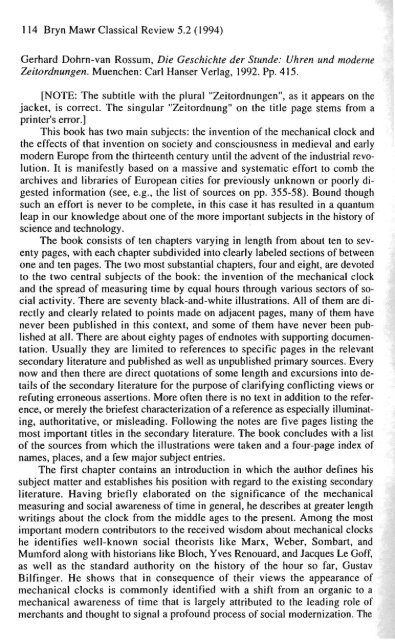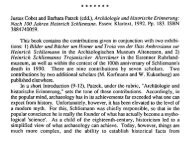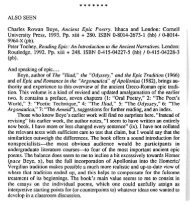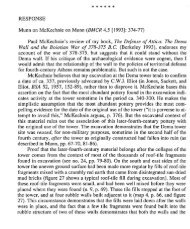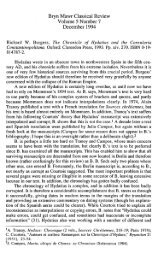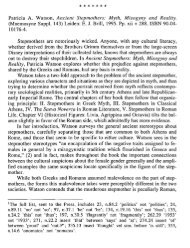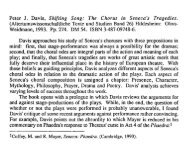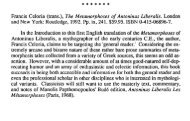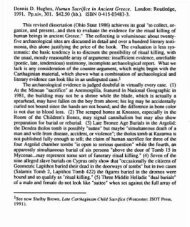Gerhard Dohrn-van Rossum, Die Geschichte der Stunde
Gerhard Dohrn-van Rossum, Die Geschichte der Stunde
Gerhard Dohrn-van Rossum, Die Geschichte der Stunde
Create successful ePaper yourself
Turn your PDF publications into a flip-book with our unique Google optimized e-Paper software.
I 14 Bryn Mawr Classical Review 5.2 (1994)<br />
<strong>Gerhard</strong> <strong>Dohrn</strong>-<strong>van</strong> <strong>Rossum</strong>, <strong>Die</strong> <strong>Geschichte</strong> <strong>der</strong> <strong>Stunde</strong>: Uhren und modeme<br />
Zeitordnungen. Muenchen: Carl Hanser Verlag, 1992. Pp. 415.<br />
[NOTE: The subtitle with the plural "Zeitordnungen", as it appears on the<br />
jacket, is correct. The singular "Zeitordnung" on the title page stems from a<br />
printer's error.]<br />
This book has two main subjects: the invention of the mechanical clock and<br />
the effects of that invention on society and consciousness in medieval and early<br />
mo<strong>der</strong>n Europe from the thirteenth century until the advent of the industrial revolution.<br />
It is manifestly based on a massive and systematic effort to comb the<br />
archives and libraries of European cities for previously unknown or poorly digested<br />
information (see, e.g., the list of sources on pp. 355-58). Bound though<br />
such an effort is never to be complete, in this case it has resulted in a quantum<br />
leap in our knowledge about one of the more important subjects in the history of<br />
science and technology.<br />
The book consists of ten chapters varying in length from about ten to seventy<br />
pages, with each chapter subdivided into clearly labeled sections of between<br />
one and ten pages. The two most substantial chapters, four and eight, are devoted<br />
to the two central subjects of the book: the invention of the mechanical clock<br />
and the spread of measuring time by equal hours through various sectors of social<br />
activity. There are seventy black-and-white illustrations. All of them are directly<br />
and clearly related to points made on adjacent pages, many of them have<br />
never been published in this context, and some of them have never been published<br />
at all. There are about eighty pages of endnotes with supporting documentation.<br />
Usually they are limited to references to specific pages in the rele<strong>van</strong>t<br />
secondary literature and published as well as unpublished primary sources. Every<br />
now and then there are direct quotations of some length and excursions into details<br />
of the secondary literature for the purpose of clarifying conflicting views or<br />
refuting erroneous assertions. More often there is no text in addition to the reference,<br />
or merely the briefest characterization of a reference as especially illuminating,<br />
authoritative, or misleading. Following the notes are five pages listing the<br />
most important titles in the secondary literature. The book concludes with a list<br />
of the sources from which the illustrations were taken and a four-page index of<br />
names, places, and a few major subject entries.<br />
The first chapter contains an introduction in which the author defines his<br />
subject matter and establishes his position with regard to the existing secondary<br />
literature. Having briefly elaborated on the significance of the mechanical<br />
measuring and social awareness of time in general, he describes at greater length<br />
writings about the clock from the middle ages to the present. Among the most<br />
important mo<strong>der</strong>n contributors to the received wisdom about mechanical clocks<br />
he identifies well-known social theorists like Marx, Weber, Sombart, and<br />
Mumford along with historians like Bloch, Yves Renouard, and Jacques Le Goff,<br />
as well as the standard authority on the history of the hour so far, Gustav<br />
Bilfinger. He shows that in consequence of their views the appearance of<br />
mechanical clocks is commonly identified with a shift from an organic to a<br />
mechanical awareness of time that is largely attributed to the leading role of<br />
merchants and thought to signal a profound process of social mo<strong>der</strong>nization. The
Bryn Mawr Classical Review 5.2 (1994) 115<br />
typical reference is to Jacques Le Goffs distinction between church time and<br />
merchant time. <strong>Dohrn</strong>-<strong>van</strong> <strong>Rossum</strong>'s central contention is that the simplified<br />
assertions <strong>der</strong>ived from this literature are, in their simplicity, mistaken. He sets<br />
out to improve our knowledge by a systematic review of the available primary<br />
sources.<br />
Chapters two and three form a prelude to the main parts of the book. Here<br />
the author reviews and clarifies the state of our knowledge about ancient and medieval<br />
methods and instruments of time-keeping until the arrival of the mechanical<br />
clock. He deals briefly with the sundials and water clocks of antiquity, but<br />
spends most of his attention on a careful description of the medieval division of<br />
the day into twelve hours of the day and twelve of the night whose length depended<br />
on a combination of the season and geographic latitude. He pays special<br />
altention to the relationship between canonical hours and hours of the day, explaining<br />
their respective functions and the most likely explanations for the differences<br />
between them. In an especially important section he describes monastic<br />
time-keeping and its defining characteristics: important is the sequence of events<br />
beginning at a particular moment in time (Easter for the yearly. vigils for the<br />
daily cycle), not the length of each event. He insists on the need for distinguishing<br />
clearly between mechanisms for waking at a particular time, measuring time<br />
in equal units, and striking bells. On that basis he rejects Mumford's and Weber's<br />
characterizations of monastic time-keeping as mechanical or rationalistic and disengages<br />
monastic time-keeping convincingly from the method of measuring<br />
time in units of identical length.<br />
Chapter four, the longest in the book, is devoted to the invention of the mechanical<br />
clock. Reviewing and in many instances correcting received views,<br />
<strong>Dohrn</strong>-<strong>van</strong> <strong>Rossum</strong> distinguishes between two main issues: the invention of the<br />
escapement and the combination of escapement-based clocks with hour-striking<br />
mechanisms. The former was by far the more important. It was the escapement<br />
which made it possible for the first time to measure time reliably and consistently<br />
in units of equal length. The lalter required at boltom nothing more than<br />
the idea to combine a revolutionary instrument with another mechanism that was<br />
developed independently, to some extent perhaps modeled on ol<strong>der</strong> bell-striking<br />
machines, and in itself by no means crucial to the introduction of mo<strong>der</strong>n timekeeping.<br />
Nonetheless, and curiously enough, there is no record for the invention<br />
of the former, whereas the lalter immediately attracted enough attention from<br />
contemporaries to have left a useful deposit in the sources. Thus it is impossible<br />
to tell who invented the mechanical clock and where or to what extent the invention<br />
was modeled on Chinese precedents.<br />
In the body of the chapter the author analyzes these issues in detail. He<br />
shows how escapements worked and how to distinguish between different kinds<br />
of clocks. He surveys the evidence for legendary inventors and describes the varieties<br />
of instruments and methods of time-keeping prior to the invention of the<br />
escapement: horologia (standard equipment in the monasteries by the 13th century),<br />
water-clocks, astrolabes. and particularly famous individual clocks. He analyzes<br />
Needham's claims for Chinese precedents and surveys the evidence surrounding<br />
the invention of the escapement. The most important sections are devoted<br />
to early bell-striking machines, the invention of the escapement, the sensa
J 16 Bryn Mawr Classical Review 5.2 (1994)<br />
tion caused in the 1330s by the appearance of mechanical clocks that were able<br />
to strike the appropriate number of bells at the appropriate hour, and the various<br />
ways of dividing the day into equal hours that emerged at the time: the Italian<br />
hour, counting twenty-four hours from nightfall to nightfall; the "Nuremberg<br />
hour", dividing day and night into anywhere from 8 to 16 hours depending on the<br />
season; and the "half hour", dividing the twenty-four hour day into two equal<br />
halves consisting of twelve hours each and beginning at midnight and noon. The<br />
chapter concludes with a brief section on the nearly simultaneous introduction of<br />
the hourglass. The author is careful to point to the difference between water<br />
clocks and hourglasses, and to insist on the novelty of the latter.<br />
Chapter five marks the transition from the story of the invention of the mechanical<br />
clock to <strong>Dohrn</strong>-<strong>van</strong> <strong>Rossum</strong>'s second main subject: the clock's impact<br />
on society. From this point on the author goes well beyond correcting received<br />
opinions by offering a wealth of genuinely new material. The subject of this<br />
chapter is the manner in which the new clocks spread throughout Europe. The<br />
author begins by reconsi<strong>der</strong>ing the standard interpretations from Bilfinger to Le<br />
Goff, defining "public clocks", and reviewing the instances in which public<br />
clocks are first mentioned. He then distinguishes several phases in, and motives<br />
for, their diffusion in the fourteenth century. He is careful to stress that whatever<br />
social utility clocks may have acquired later on is unlikely to have functioned as<br />
a major motive in their initial diffusion. Demonstrable is the role of monarchs<br />
and princes who insisted on installing public clocks, sometimes against the resistance<br />
of merchants unwilling to pay the cost. More important were the initiatives<br />
of cities not wishing to lose face in the competition for urban prestige with<br />
other cities already equipped with clocks. And finally, since the early fifteenth<br />
century, it became common for governments urban and otherwise to require the<br />
introduction of clocks in their territories by administrative decree. The chapter<br />
concludes with a carefully balanced statistical analysis of the spread of clocks<br />
along temporal and spatial lines in the fourteenth century.<br />
The main results of this analysis are that public clocks were introduced in<br />
northern Italy early in the fourteenth century, spread unevenly for about two generations,<br />
experienced a genuine boom in the I370s, and had by the end of the<br />
fourteenth century become a standard piece of public equipment for any self-respecting<br />
city. It is thus true that the spread of clocks is inextricably connected to<br />
towns and cities, but there is consi<strong>der</strong>able evidence that this was due to other factors<br />
than any special role played by merchants, and no evidence that it was. It is<br />
true as well that the introduction of clocks is related to urban mo<strong>der</strong>nization, but<br />
is best un<strong>der</strong>stood as part of a larger process including many other parts (e.g.,<br />
schooling, mills, engineers, and fiscal administration) which proceeded according<br />
to their own logic and were by no means necessarily related to the introduction<br />
of clocks.<br />
Chapter six is devoted to a survey of clock makers in the late middle ages. It<br />
appears that there was no single group or craft of clock makers but that the required<br />
skills were distributed over a consi<strong>der</strong>able variety of social groups none of<br />
whose members drew their income exclusively from clock making. Until the invention<br />
of the mechanical clock clock makers are predominantly found in a<br />
monastic environment. Thereafter the picture changes. The most famous clock
Bryn Mawr Classical Review 5.2 (1994) 119<br />
with each other than infractions of rules about the quality of an activity. That<br />
made their enforcement both "more just" and less susceptible to dispute.<br />
Having made these central points, the author concludes the chapter with a<br />
look at two especially entertaining areas of social activity: torture and science.<br />
The new measurement of time was enthusiastically used to establish and rank<br />
different degrees of torture. But contrary, perhaps, to the expectation and, certainly,<br />
to the widely held view that science must have been in the forefront of<br />
temporal innovation. the mechanical measurement of time turns out to have<br />
played a minimal role in science until the scientific revolution of the seventeenth<br />
century and the invention of more precise clocks in the eighteenth. The prominence<br />
of the mo<strong>der</strong>n measurement of time in an activity of such obvious importance<br />
for social or<strong>der</strong> as torture and its late appearance in the realm of science add<br />
further weight to the author's contention that the ad<strong>van</strong>tages of the new measurement<br />
of time for purposes of control and enforcement were a central factor in<br />
their spread. It also reinforces his view that-with all due respect to Thorndike,<br />
Mumford. and Crombie-the arrival of the mechanical clock is not to be<br />
confused with the arrival of scientific rationality. Until the early nineteenth<br />
century life according to the clock had little to do with any concept of "physical<br />
time" but remained more or less synonymous with life un<strong>der</strong> an urban<br />
government.<br />
In chapter nine the author turns to the significance of the new measurement<br />
of time for the regulation of work. His central point here is that until the eighteenth<br />
century the day remained the most important and fundamental temporal<br />
unit in which amounts of work were measured. Measuring and paying labor by<br />
the hour was rare except in cases of work beyond normal limits and failure to<br />
appear for work. At the same time the new measurement of time had a significant<br />
impact on the organization of work well before the appearance of factories<br />
and industrialization. This was mainly because here as in previously discussed<br />
contexts precisely fixed schedules made it easier to formulate and enforce compromises<br />
between the conflicting interests of workers, employers, and the members<br />
of different crafts and guilds. In the late middle ages it already became apparent<br />
that canonical hours were too uncertain a means of measuring time to allow<br />
for effective conflict resolutions. Bells were introduced to indicate the beginning<br />
and end of the workday as well as the times allotted for breaks in different<br />
rhythms for different occupations. With the introduction of the clock it became<br />
possible to fix those times with increasing precision, gradually to replace different<br />
bells for different areas of work by reference to the urban clock. and to place<br />
more clearly identifiable limits on the amount of work expected by employers.<br />
In this fashion the measurement of time had gained a prominent place in the reguJalion<br />
of work well before industrialization. What is true is that with the spread<br />
of factories. factory clocks. and privately owned watches since the eighteenth<br />
century the monopoly of the urban clock was broken while conflicts over work<br />
time began to center on control over the factory bell. The chapter concludes with<br />
a few brief observations about early forms of the obsessively detailed form of<br />
temporal planning known as Taylorism.<br />
Chapter ten is designed to bring the story of the medieval and early mo<strong>der</strong>n<br />
introduction of the clock to a conclusion by identifying the markers distinguish
Bryn Mawr Classical Review 5.2 (1994) 121<br />
cusing on the nearly simultaneous emergence of the clock and the hourglass as<br />
the most important instruments of keeping time he is able not only to dispel the<br />
myth of the supposed antiquity of the hourglass but also to relate the appearance<br />
of both to un<strong>der</strong>lying social changes.<br />
In other cases Dohm-<strong>van</strong> <strong>Rossum</strong> exposes the apocryphal nature of familiar<br />
stories that have often been credited with the status of primary evidence and used<br />
to un<strong>der</strong>gird misleading accounts. Noteworthy among them are the belief that<br />
King Charles V of France issued an ordinance making the new reckoning by the<br />
hour mandatory (pp. 202-204), the supposed twelfth-century clock maker guild<br />
of Cologne (pp. 95-97), and the identification of master Henlein with the inventor<br />
of the pocket watch known as the "Nuernberger Ei" (pp. 118-20). In other<br />
cases he is able to draw on his comprehensive knowledge of the evidence to expose<br />
misinterpretations in the secondary literature. Telling cases are A. C.<br />
Crombie's belief that time reckoning by minutes became important in the later<br />
middle ages (pp. 260-61); the con fusion between the mechanical clock and the<br />
hour-striking clock (p. 348 n. 180); and the confusion of Dondi's astrarium with<br />
a church clock (p. 124 and p. 353 n. 5). The number of similar improvements<br />
on the existing secondary literature is too large to detail, but a sampling of the<br />
following endnotes will enlighten the curious: pp. 330 n. 13, 333 n. 9, 340 n.<br />
95,342 nn. 109 and 113,347 n. 165,349 n. 189,367 n. 29, 373 n. 31, 391 n.<br />
36, 398 n. 30.<br />
Above all else, however, <strong>Dohrn</strong>-<strong>van</strong> <strong>Rossum</strong> has thoroughly reshaped the<br />
history of the clock and time-keeping. In spite of the respect with which he<br />
treats previous views as epitomized by Le Goffs emblematic distinction between<br />
church time and merchant time, there is no doubt that his account ren<strong>der</strong>s those<br />
views obsolete. In the central chapters of the book he has broken entirely new<br />
ground. Where there used to be a plausible but schematic thesis, there is now a<br />
detailed and very different story that has never been told before, throwing bright<br />
light on such different phenomena in the history of European society and technology<br />
as the organization of torture and the ringing of bells, painting a kaleidoscopic<br />
picture of the uses of clocks and time in late medieval and early mo<strong>der</strong>n<br />
Europe, and creating a vivid image of some of the most salient aspects of life in<br />
European cities before the industrial revolution. What stands out in the rea<strong>der</strong>'s<br />
memory are the exuberant profusion of bells ringing all day for all sorts of purposes<br />
before the appearance of the clock, the excitement about the new machine,<br />
the desire of towns and princes to have the best and biggest clocks, the sheer<br />
variety and complexity of late medieval and early mo<strong>der</strong>n social life, the<br />
thoroughness with which the effects of the clock spread into the nooks and<br />
crannies of that life, the faint weight of the distinction between clerics and<br />
merchants, the fundamental importance of cities in defining the social space of<br />
late medieval and early mo<strong>der</strong>n Europe, and the anonymous logic of a process of<br />
mo<strong>der</strong>nization in which the clock played a major part.<br />
At the same time <strong>Dohrn</strong>-<strong>van</strong> <strong>Rossum</strong> wears his learning lightly. If it is evident<br />
that his book is founded on massive research, it is evident as well that the<br />
evidence supporting his results is marshaled without pedantry and only as far as<br />
necessary to make a point. Clearly a great deal more could have been said, and<br />
doubtless was said in the "Habilitationsschrift" of which this book is a
122 Bryn Mawr Classical Review 5.2 (1994)<br />
condensation. Anyone who has ever attempted to draw a complete picture of<br />
anything on the basis of medieval sources will appreciate the unpretentious<br />
brevity with which major results are here presented as if it had not taken years to<br />
compile them (see, e. g., the list of dates about the spread of the clock on p. 362<br />
n. 90). The author writes refreshingly unacademic German, clear and to the<br />
point. He eschews polite qualifications in favor of firm judgments, leaving no<br />
doubt in the rea<strong>der</strong>'s mind about his reasons for holding a given view to be<br />
wrong or misleading. He defines his terms with exemplary clarity and<br />
distinguishes wherever distinctions are needed, making it unexpectedly easy for<br />
the rea<strong>der</strong> to follow an argument about the complicated effects of a complicated<br />
piece of technical equipment. Above all else, however, the author resists the<br />
temptation to engage in extended arguments. Firm in his conviction that the<br />
distinctive merits of his case rest on fresh evidence, he is content to present the<br />
evidence in a manner that persuades by its clarity and detail rather than the<br />
author's personal intervention. Un<strong>der</strong>statement is the most pervasive quality of<br />
this book.<br />
That may make it difficult for the uninitiated to appreciate the novelty of<br />
<strong>Dohrn</strong>-<strong>van</strong> <strong>Rossum</strong>'s account. And there are points at which it may conflict with<br />
the interest of scholars wishing to retrieve the sources on which it is based, for<br />
example, in the bibliography and the index. Given the great amount of primary<br />
and secondary sources that have here been systematically evaluated and updated,<br />
future research would surely have benefited from a complete list of the primary<br />
and secondary sources cited in the notes. The concise list of the most important<br />
titles which is currently furnished on pp. 403-407 seems addressed at an audience<br />
with little patience. And given the great number of occasions on which specific<br />
pieces of information are strategically placed to illuminate a broa<strong>der</strong> subject, it<br />
would surely have helped to have a more detailed index.<br />
On the other hand, however, the author's preference for un<strong>der</strong>statement is<br />
perhaps the quality most likely to assure this book a long life and a larger audience<br />
than is common for books founded on massive scholarly efforts. Here is a<br />
story that is largely new and attractive to rea<strong>der</strong>s extending from c1ockophiles,<br />
via academic historians, sociologists, and anthropologists of many different<br />
stripes and colors to anyone with a serious interest in the impact of technology<br />
on society. Here is also a story that is unlikely to change for many years to<br />
come, either in its main outline or in its substance, because of the author's determined<br />
effort to let the sources speak as much as possible for themselves and<br />
to refrain from explicating his reasoning except where absolutely necessary, and<br />
then briefly. That a great deal of reasoning has in fact gone into the shaping of<br />
the story is evident to any careful rea<strong>der</strong>, but it is deployed with unusual economy.<br />
Anyone with a vested interest in the subject and perhaps a desire to tell a<br />
somewhat different story will therefore think twice before attacking positions so<br />
well defended by powerful weapons and so likely to be supplied with more ammunition<br />
than has here been put on display. I would be surprised if this book<br />
does not become the standard authority on its subject for a generation of<br />
scholarship. I would be surprised as well if it does not generate a consi<strong>der</strong>able<br />
amount of new research on the many different strands in the history of the clock
Bryn Mawr Classical Review 5.2 (1994) 123<br />
and the measurement of time that <strong>Dohrn</strong>-<strong>van</strong> <strong>Rossum</strong> has been the first to<br />
identify.<br />
Constantin Fasolt<br />
University of Chicago<br />
*******


